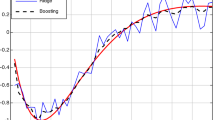Abstract
Understanding the empirical success of boosting algorithms is an important theoretical problem in machine learning. One of the most influential works is the margin theory, which provides a series of upper bounds for the generalization error of any voting classifier in terms of the margins of the training data. Recently an equilibrium margin (Emargin) bound which is sharper than previously well-known margin bounds is proposed. In this paper, we conduct extensive experiments to test the Emargin theory. Specifically, we develop an efficient algorithm that, given a boosting classifier (or a voting classifier in general), learns a new voting classifier which usually has a smaller Emargin bound. We then compare the performances of the two classifiers and find that the new classifier often has smaller test errors, which agrees with what the Emargin theory predicts.
Similar content being viewed by others
References
Freund Y, Schapire R E. Experiments with a new boosting algorithm. In: International Conference on Machine Learning (ICML), Bari, 1996
Freund Y, Schapire R E. A decision-theoretic generalization of on-line learning and an application to boosting. J Comput Syst Sci, 1997, 55: 119–139
Bauer E, Kohavi R. An empirical comparison of voting classification algorithms: Bagging, boosting and variants. Mach Learn, 1999, 36: 105–139
Dietterich T. An experimental comparison of three methods for constructing ensembles of decision trees: Bagging, boosting and randomization. Mach Learn, 2000, 40: 139–157
Viola P, Jones M. Rapid object detection using a boosted cascade of simple features. In: IEEE Computer Society Conference on Computer Vision and Pattern Recognition (CVPR), Kauai, 2001
Caruana R, Niculescu-Mizil A. An empirical comparison of supervised learning algorithms. In: 23th International Conference on Machine Learning (ICML), Pittsburgh, 2006
Friedman J, Hastie T, Tibshirani R. Additive logistic regression: A statistical view of boosting. Ann Stat, 2000, 28: 337–407
Jiang W. Process consistency for adaboost. Ann Stat, 2004, 32: 13–29
Lugosi W, Vayatis N. On the bayes-risk consistency of regularized boosting methods. Ann Stat, 2004, 32: 30–55
Zhang T. Statistical behavior and consistency of classification methods based on convex risk minimization. Ann Stat, 2004, 32: 56–85
Bartlett P, Jordan M, McAuliffe J D. Convexity, classification, and risk bounds. J Am Stat Assoc, 2006, 101: 138–156
Mease D, Wyner A. Evidence contrary to the statistical view of boosting. J Mach Learn Res, 2008, 9: 131–156
Schapire R, Freund Y, Bartlett P, et al. Boosting the margin: A new explanation for the effectiveness of voting methods. Ann Stat, 1998, 26: 1651–1686
Grove A J, Schuurmans D. Boosting in the limit: Maximizing the margin of learned ensembles. In: National Conference on Artificial Intelligence (AAAI), Wisconsin, 1998
Breiman L. Prediction games and arcing algorithms. Neural Comput, 1999, 11: 1493–1517
Reyzin L, Schapire R E. How boosting the margin can also boost classifier complexity. In: International Conference on Machine Learning (ICML), 2006
Koltchinskii V, Panchenko D. Empirical margin distributions and bounding the generalization error of combined classifiers. Ann Stat, 2002, 30: 1–50
Koltchinskii V, Panchenko D. Complexities of convex combinations and bounding the generalization error in classification. Ann Stat, 2005, 33: 1455–1496
Wang L, Sugiyama M, Yang C, et al. On the margin explanation of boosting algorithms. In: 21th Annual Conference on Learning Theory (COLT), Helsinki, 2008
Wang L, Sugiyama M, Jing Z, et al. A Refined Margin Analysis for Boosting Algorithms via Equilibrium Margin. J Mach Learn Res, 2011, 12: 1835–1863
Rätsch G, Schölkopf B, Smola A, et al. ν-arc: Ensemble learning in the presense of outliers. In: Solla S A, Leen T, Müller K-R, eds. Proceedings of Advances in Neural Information Processing Systems (NIPS)). Cambridge: MIT Press, 1999
Demiriz A, Bennet K, Shawe-Taylor J. Linear programming boosting via column generation. Mach Learn, 2002, 46: 225–254
Bennett K, Demiriz A. Semi-supervised support vector machines. In: Proceedings of the Conference on Advances in Neural Information Processing Systems (NIPS). Cambridge: MIT Press, 1999. 368–374
Asuncion A, Newman D J. UCI machine learning repository, 2007. Available from: http://www.ics.uci.edu/~mlearn/MLRepository.html
Author information
Authors and Affiliations
Corresponding author
Rights and permissions
About this article
Cite this article
Wang, L., Deng, X., Jing, Z. et al. Further results on the margin explanation of boosting: new algorithm and experiments. Sci. China Inf. Sci. 55, 1551–1562 (2012). https://doi.org/10.1007/s11432-012-4602-y
Received:
Accepted:
Published:
Issue Date:
DOI: https://doi.org/10.1007/s11432-012-4602-y




